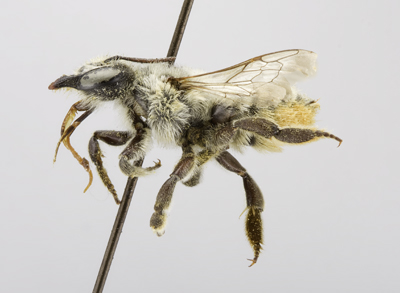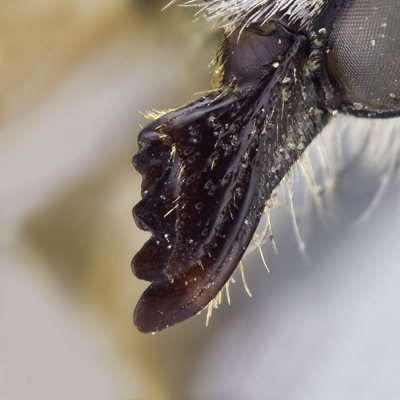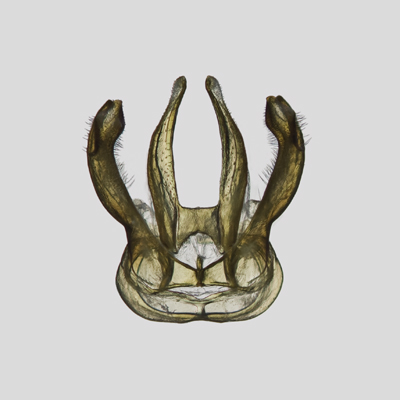
32. Megachile (Xanthosarus) dentitarsus Sladen, 1919
Megachile dentitarsus Female |
Megachile dentitarsus Male |
Megachile diligens Sladen, 1918. Agr. Gaz. Canada 5: 125 (♂, ♀) (preoccupied).
Megachile dentitarsus Sladen, 1919, Can. Entomol. 51: 85 (replacement name for M. diligens Sladen, 1918).
Diagnosis.The female of M. dentitarsus can be recognized by the combination of 5-dentate mandibles, with the 4th tooth approximately parallel-sided throughout its length, with an oblique emargination between 3rd and 4th teeth which is much deeper than emargination between 2nd and 3rd teeth, the relatively dense and conspicuous white metasomal fasciae, and the absence of dark pubescence on the mesosoma. They are most similar to M. latimanus, M. perihirta and M. fortis. Females of M. latimanus and M. perihirta have the metasomal terga with fasciae less dense and usually interrupted medially on the more basal terga, and much dark pubescence on the mesosoma. Females of M. fortis have the emargination between 3rd and 4th teeth about three times as wide as width of 4th tooth at midlength, with the emargination broadly semi-circular in shape, and is generally much larger. The male of M. dentitarsus can be recognized by the combination of pale, highly modified front legs, lack of a mid-tibial spur, mid basitarsus bearing a large, quadrate, ventral protuberance, and the small sharp spines on the mesosternum. They are most similar to M. latimanus and M. perihirta. Males of M. perihirta have the mid basitarsus bearing a keel-shaped protuberance. Males of both species lack the small sharp spines on the mesosternum, being represented by low carinae.
FEMALE: Length 13-14 mm.
Head:
Figure M32: Megachile dentitarsus female mandible |
1) compound eyes subparallel; lateral ocelli slightly nearer edge of vertex than eyes (4: 4.5), 2) clypeal margin straight, faintly and irregularly crenulate, apical rim slightly thickened and shiny, 3) mandibles 5-dentate, with 4th tooth approximately parallel-sided throughout its mid-length; deep oblique emargination between the 3rd and 4th teeth much deeper than emargination between 2nd and 3rd teeth, width of emargination between 3rd and 4th teeth about twice width of the 4th tooth at midlength, shallow but distinct emargination between 4th and 5th teeth, with complete cutting edges between 3rd and 4th and 4th and 5th teeth, incomplete between the 2nd and 3rd teeth (Figure M32), 4) gena slightly broader than compound eye (4:3.5), 5) punctures fine and close, but relatively shallow on gena and vertex medially, with shiny interspaces apparent laterally, somewhat more coarse but close on clypeus except for an indefinite median impunctate line; sparse on supraclypeal area, especially medially, 6) pubescence white on head, dense below median ocellus and around antennae to margin of eye, long and sparse on lower gena, vertex with brown hair laterally, clypeus sparsely pubescent, 7) F1 longer than broad (5:3) and longer than pedicel and F2, which is about as long as broad, remaining flagellomeres slightly longer than broad (3:2), apical flagellomere more elongate, twice as long as broad.
Mesosoma:
1) pubescence white, copious though hardly concealing the surface, shorter dorsally, mesoscutum occasionally with a transverse median brownish patch, 2) punctures close and rather fine on dorsal surface, but more coarse and distinct in centre of mesoscutum and scutellum, fine and close on pleura and propodeum, triangle rather dull and impunctate, 3) basitarsi of mid and hind legs slightly narrower than their tibiae, hind basitarsus almost as long as its tibia, spurs yellow, 4) tegula deep reddish-brown, somewhat shining, but with exceedingly minute and close punctures, pubescent anteriorly, 5) wings hyaline basally, faintly clouded apically, the veins brownish-black.
Metasoma:
1) terga hardly depressed basally, apical margins of T2-T5 depressed; punctures minute , close on basal terga but becoming more distinct and separate to T5, close on T6; pubescence white on T1 and T2, T3-T5 with some black pubescence on discs, on T6 entirely white, erect basally, more or less appressed apically, T2-T5 with quite broad and dense white apical fasciae, entire except on T2, 2) scopa bright yellowish-white, somewhat paler basally, S6 with a narrow row of stiff, short bristles on rounded apical edge; punctures fine and close on basal sterna, becoming slightly more sparse on apical ones.
MALE: Length 12-13 mm.
Head:
1) compound eyes very slightly convergent below; lateral ocelli slightly nearer eyes than edge of vertex (7:8), 2) clypeal margin produced medially, impunctate with a few minute indentations medially, 3) mandible 3-dentate, lower margin of mandible straight between the apical tooth and apex of basal lower process, lower edge amber in colour, lower basal process quite narrow and elongate, apex obliquely acute, densely pubescent on inner surface, 4) gena broader than compound eye (4:3), with a concave, shelf-like tubercle at lower margin that receives tip of the lower mandibular process when closed, 5) punctures close and fine on gena and vertex medially, on face below ocelli, and on clypeus below the dense pubescence, more coarse and slightly more sparse on vertex laterally, 6) pubescence entirely pale yellow, bright in some specimens, with no evident dark admixture, elongate and dense on face below ocelli, less copious on vertex, becoming short and sparse on gena, which have a pair of lines of short white hairs along lower margin adjacent to the densely white pubescent tubercle at lower edge of gena, 7) F1 about as long as broad, and very slightly longer than pedicel, considerably shorter than remaining flagellomeres, which are longer than broad (3:2), apical flagellomere more elongate, twice as long as broad.
Mesosoma:
1) pubescence entirely pale yellow, almost white in some specimens, front tarsal fringes whitish, more yellowish basally and beneath, dark brown at tip; mid tarsal fringe long and thin, entirely pale yellow, 2) punctures close and fine over entire surface, propodeum with surface more shiny, punctures more shallow and well spaced (> 1pd), especially medially, triangle shiny and impunctate, 3) front coxal spine flattened, robust and rather long, tip triangularly pointed, coxal surface bare; front femur with a keel on lower margin apically that is obscured by dense pubescence of posterior face, reddish-brown except for dark apical portion of the posterior face; front tibia largely reddish-brown, but outer face dark basally and yellow apically; front tarsus yellow, front basitarsus subequal in length to tarsomeres 2-4 combined, about equally as broad at apex as at base, and but slightly produced apically; middle femur swollen, the lower surface flattened and slightly concave, mid tibia rather slender and slightly curved, lacking the usual apical spur, basitarsus with a subquadrate obtuse protuberance beneath; hind tibia slightly curved, anterior margin of its basitarsus rounded; mesosternum with a small slender acute spine anterior to each mid coxa, spurs yellow, 4) tegula yellowish anteriorly, becoming darker posteriorly, with punctures fine and evenly dispersed, 5) wings subhyaline, slightly clouded apically, veins reddish-brown to black.
Metasoma:
1) T2-T5 depressed basally with the edge distinctly though not strongly carinate, apical margins of T3-T5 quite distinctly depressed, that of T2 only toward the sides, disc of T6 vertical, the carina short, with a small median emargination that is often vague and indefinite, finely denticulate or crenulate on each side, median teeth on apical edge distinct, much nearer lateral teeth than to each other, T7 with a very minute median triangularly pointed projection; punctures minute and close on basal terga, becoming somewhat more distinct and sparse on the shining discs of T4 and T5, minute, shallow and close on T6; pubescence on discs of terga entirely pale yellow, whitish in some specimens, with no evident dark admixture, copious on T1 and T2, the apical fasciae narrow but complete on T3-T5, narrow medially on T2, 2) S1-S4 exposed, apical margins slightly depressed and more or less hyaline; punctures of sterna fine and relatively close; pubescence entirely pale, sparse and rather long on discs, arranged apically into a long fringe, medially interrupted on S4.
Genitalia: Figure G32.
|
Figure G32: Megachile dentitarsus genitalia |
Discussion:
This species is a ground nester (Hobbs and Lilly 1954; Bohart 1957) (Table 1) and visits several forage crops including alfalfa and red clover in the prairies (Hobbs 1957; Hobbs et al. 1961).
Distribution:
Southern SK and the southern half of AB (see Map 32).
|
Map 32: Canadian distribution of Megachile dentitarsus |




